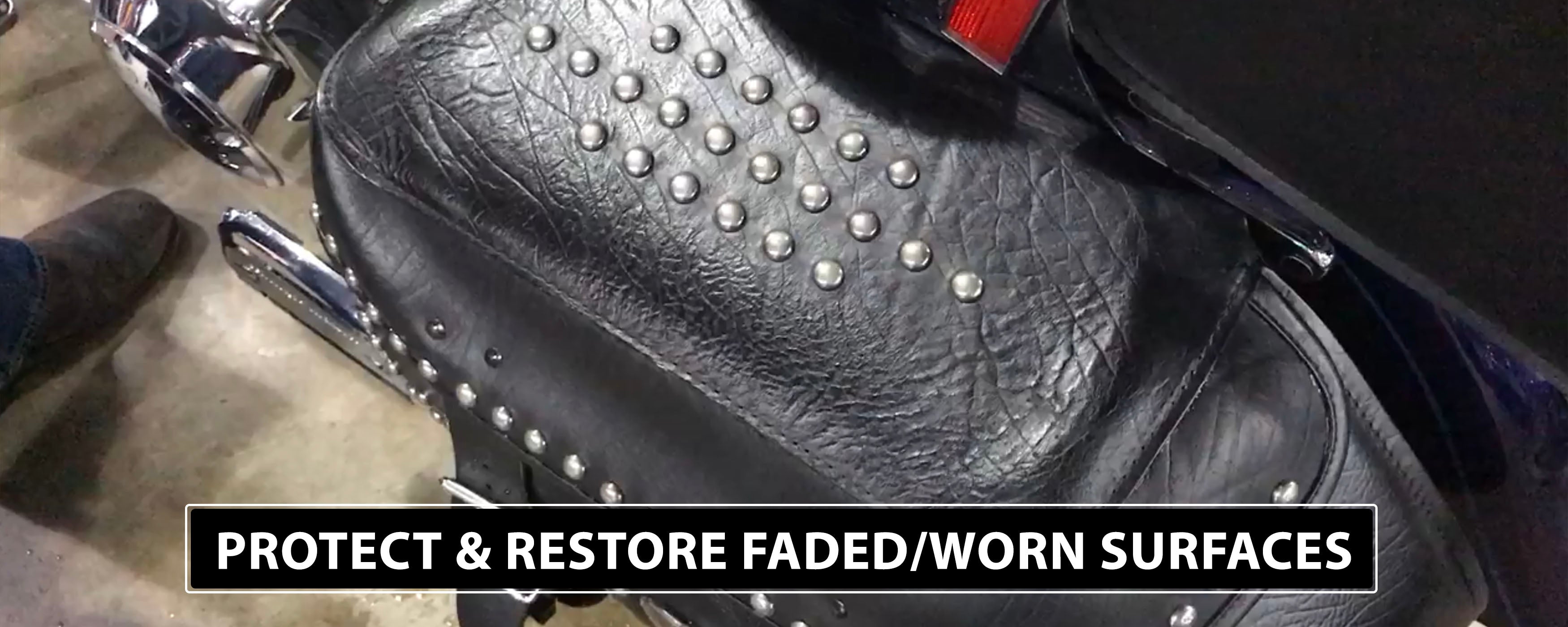FREE US SHIPPING ON ORDERS $75+ (LOWER 48 STATES)
FREE DETAILING ADVICE +1-877-838-2672

When you are out and about, you may notice vehicles that have faded paint, and if you are a car enthusiast seeing such may irritate you. However, when it is your car, truck, SUV, RV, or even ATV that has worn or faded paint ,you want to do something about it immediately. So, the question arises, what is the best way for restoring faded or worn paint surfaces and then protect them from further fading?
Before we can give a clear answer on how to restore faded or worn painted surfaces without repainting them, you have to first understand the causes of fading paint.
Most cars are mass-produced to meet certain standards, which are usually just enough to pass an inspection from a few feet away. The imperfections of mass-produced vehicles can vary, and without proper care over the course of months or years, painted surfaces may wear down, starting with the clear coat.
In most cases of visibly faded or worn paint, the clear coat or lack thereof is the culprit. The clear coat is the first layer to break down on modern-day vehicles, which is the coating that usually provides the gloss or luster of a paint, and ultimately provides some initial protection. UV rays are a primary source of breaking down a clear coat if it is left unprotected, in addition to allowing elements to build up on the clear coat and allowing them to bake-in over time from heat and the sunlight’s UV rays. It’s almost like your skin getting sunburned – it happens if you stay out in the sun long enough with the proper sunscreen or protection. Well, if your vehicle is left outside in the sun and exposed to harsh elements, it will eventually break down, ‘getting sunburned’ if it is not protected.
The fading and wear may also be a byproduct of corrosion, where salt from the water stays on the surfaces and eventually oxidizes and eventually eating away at the clear coat. Oxidation will often cause the clear coat to chip and peel away and then leave the actual paint underneath vulnerable to damage, which usually requires repainting - as in these cases the paint and clear coat is too far gone to restore.
Apart from contaminants, pollutants, and UV rays wearing away at your clear coat, abrasive cleaners or chemicals can cause a breakdown of your clear coat, and eventually, your paint. While most trusted cleaning products and chemicals are safe and perfectly pH balanced, some may contain harsh abrasives, VOCs (volatile organic compounds), have a negative pH balance (are acidic), or have a higher positive pH balance (alkaline base) and cause clear coats to break down.
When using cleaning products or even sealants, it is best to use one that is either water-based or has fewer chemical agents that are pH balanced. Remember, you don’t want to do any more harm in restoring and protecting your faded or worn clear coat and paint.
Before you restore a painted vehicle surface, it is best that you determine if you have a clear coat (two-stage paint) or a one-stage that lacks a clear coat. Once you have figured this out, either by looking up your vehicles VIN or do some research, you may start restoration.
Restoration of clear coat painted surfaces is easier and the most common type when using do-it-yourself (DIY) products. The first step is to wash the vehicle and remove all contaminants, which is a process of clay baring the vehicle after a wash.
Once the vehicle is clean and free of contaminants, you can then start buffing the vehicle using the proper pad and orbital power tool, along with a buffing compound. Depending on how bad the fading is and how deep you wish to “cut” into your clear coat will determine which compound to use, as there are many to choose from.
Pro tip: You never want to cut too deep into your clear coat or burn your clear coat/paint with a heavy compound or aggressive buffing. You may even seek advice from professional detailers if you are unsure where to start.
Once you have successfully buffed your faded or worn surfaces, you will want to protect them with a good paint sealer to prevent further damage or fading.
Protecting your restored paint is essential as it has already gone through some damage, and you may have been lucky enough to bring it back to a desirable level of luster/glossiness and shine. You may choose to either ceramic coat the surface or apply a long-lasting paint sealant, like TopCoat® F11® or TopCoat® F11PRO®. Sealants like TopCoat® F11® and TopCoat® F11PRO® will provide optimal protection outside of ceramic coating for a durable and long-lasting sealant that repels water and elements through hydrophobicity and many other advanced technologies.
The use of a sealer like TopCoat® F11® or TopCoat® F11PRO® will also ensure that harmful UV rays do not cause additional damage or allow elements to penetrate the clear coat to further break it down. Moreover, your surface will stay cleaner longer by keeping elements that lead to fading from clinging to the surface.
If you choose to ceramic coat your vehicle, be sure to use a coating that doesn’t claim to be hard as a diamond, as you may experience chipping of the coating as it does not bend or flex with the body surfaces. TopCoat® has the perfect solution in TopCoat® Crystaleen®, a DIY professional ceramic coating.

We want you to be 100% satisfied with everything you buy from TopCoat. And if you’re not entirely happy with your purchase we will refund your money in full, or exchange the goods. All we ask is that you contact our customer services and then return the products back to us.